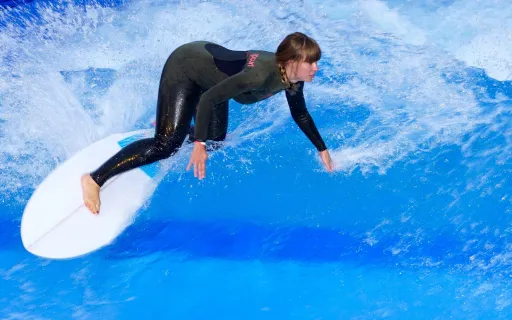The Czechs aren’t lucky enough to have their own sea, which is tough for those who are drawn to surfing. We can’t just hop in a car and be on a beach in twenty minutes with a board in hand and the wild ocean ahead. So we head abroad—to France, Portugal, Sri Lanka, Australia, and beyond.
Fortunately, people are inventive and find ways to replace what they lack. Thanks to that ingenuity, surfing is possible even here at home. Let’s talk about indoor surfing.

We know it’s not a hot new trend, but there are still folks who haven’t heard of indoor surfing. Some dream of trying surfing but don’t dare jump straight into the ocean. Others aren’t afraid, but before they even learned the basics, their holiday ended—and the next chance won’t come until a year later. That can feel frustrating, like they wasted precious time splashing around instead of actually surfing.
Indoor surfing can solve that problem. You’ll learn the basics under an instructor’s supervision, and you’ll surf much better on your next vacation.

Did you know surfing appeared for the first time as an official Olympic sport at the 2020 Games?
So what is indoor surfing?
Not everyone speaks English, so you could translate it as “hall surfing,” though indoor surfing definitely sounds better. It simply takes place under a roof on a simulator that mimics ocean swell. You probably know the term “artificial wave”. Here’s what that means.
The first surfing on an artificial wave happened in Texas, USA, in 1991, and since then hundreds of venues have sprung up worldwide where you can try indoor surfing. Thanks to its accessibility and safety, indoor surfing keeps growing in popularity—many people even prefer it to ocean surfing.
Indoor surfing—how does it work? First, you need an “artificial wave.”
There are several technologies for creating artificial waves. For systems designed specifically to generate waves for indoor surfing, the most commonly used in the Czech Republic is the so-called FlowRider trainer. Here, a stream of water is driven upward along a rising “track” whose shape imitates a wave. Beneath it sits a water reservoir, powerful pumps, and other tech. The water volume can be up to 300 cubic meters.
Another approach uses a special pool where pumps push water at high speed over an obstacle on the bottom. The flow breaks and forms waves. The well-known American indoor surfing technology—Surfstream—even uses movable obstacles of different sizes and curvatures to create various types of waves.

Surfing was likely invented by the indigenous people of the Hawaiian Islands. It remains deeply rooted in Hawaiian society, religion, and wider Polynesian mythology.
Indoor surfing sounds like fun
It is fun—no doubt about it. And it has perks! For example:
- Indoor surfing is safer than ocean surfing.
- No waiting for waves when you surf indoors.
- For beginners, it’s great that an instructor is right there with you on the artificial wave.
- You can do it anytime—weather doesn’t limit you.
- Indoor surfing teaches not only the basics but also advanced tricks you can one day show off in the ocean.
- On artificial waves, friends or family can easily watch or film you, and many simulators allow multiple surfers at once.
- Related to #1: No risk of shark attacks or stingray stings. An artificial wave isn’t exactly their kind of habitat. ;-)
But surfing on an artificial wave isn’t necessarily easy
It isn’t hard either, and you’ll have plenty of laughs while learning. You don’t need to master fancy moves right away—that comes with time. You may even find you prefer simply riding lying on your stomach. That’s likely how you’ll start with indoor surfing, a position known as bodyboarding.
There are lots of bodyboarders, and they even write articles on why lying down beats standing. They have their own, shorter boards called bodyboards. You don’t have to ride only on your belly—you can go on your knees or even seated. Bodyboarding is also great for anyone a bit nervous about indoor surfing who needs time to get used to the setting, the fast-moving water beneath them, and so on.

Indoor surfing for every household!
We feel the same way—though you’d have to be a millionaire to build your own artificial wave at home. So we’ll settle for visiting venues that offer indoor surfing. In the end, that’s actually better: owning a surf simulator brings responsibilities, and you’re here to have fun!

Even pro surfers use indoor surfing for training.
Indoor surfing can entertain the whole family or a lively group of friends. Even if you don’t plan to surf choppy ocean waves, we recommend trying indoor surfing at least once. Chances are you won’t stop at a single session—and you might even discover a new hobby. Who knows, maybe you or your child has a hidden talent just waiting to be found.

